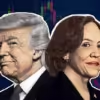The year 2022 was everything but favourable for the Indian currency. Even though, India emerged as one of the fastest growing among its counterparts, at a time dominated by global economic recession, the nation’s currency fared the worst this year—its nine years’ low.
Worst performance since 2013
With a depreciation of more than 11 percent, the year marks the rupee’s worst performance since 2013. However, market expert Sugandha Sachdeva, explains, “Barring gains of around six percent in 2017, the Indian currency has been on a losing spree since CY11 and 2022 was no exception.”
The rupee breeched the 83 mark vs the US dollar in October and on Tuesday, December 27, the rupee settled its trading at 82.65 vs dollar, nearly half a percent up from its all time low.
The dollar index – which measures the value of greenback against a basket of six peers – surged to a two-decade high of around 115 in the third quarter of the year on the back of aggressive interest rate hikes by the US Fed. The rate hikes caused significant outflows from the domestic markets which led to a depreciation in the rupee.
The value of the US dollar against a basket of six peers is inversely proportional to the value of rupee. That is, if the value of greenback rises, the value of rupee depreciates and vice versa.
While for first half, the rupee came out as the relatively better performing currency amongst other emerging markets, it slipped to being the worst among its peers.
“The major underperformance of the rupee, on a comparative basis, was seen over the last two months when Developed and Emerging market currencies showed some recovery as the US dollar index fell by almost 10 percent on two consecutive falls in US core inflation,” explains Amit Pabari, Managing Director at CR Forex.
Earlier in December, the twelve-month implied rupee yields slipped to the lowest since 2009. This made trade less attractive for foreign investors.
International trade in rupee
The government is promoting and many nations including neighboring countries Sri Lanka and Bangladesh have accepted international trade in rupee. The country is working toward establishing a a rupee-dirham payment mechanism with the UAE. According to Bloomberg, the initial agreement on the mechanism might be point in place as early as January.
Currently rupee trade arrangements are with Russia, Mauritius and Sri Lanka through Special Rupee Vostro Account (SRVA). Indian banks have already opened SRVA with banks of these three nations, operationalising the rupee trade arrangement.
Following the Russia-Ukraine war and the sanctions imposed by the West, India has been trying to promote rupee trade.
In July, the RBI announced that an arrangement will be put in place for Indian and foreign entities to settle cross-border trade payments in rupees. All exports and imports can be denominated and invoiced in rupees, with the exchange rate being market-determined, RBI had said.
Where did the government step in?
“The RBI tried to curb the volatility and depreciating move this year by regularly intervening in the market through spot, forward, and futures and took a timely call on monetary policy to ease the inflationary pressure,” says Pabari.
Sachdeva explains that the international rupee trade settlement will “gradually reduce the dependency on US dollar, the world’s reserve currency, and reduce dollar outflows.” “While this move is largely aimed at facilitating trading with Russia due to sanctions by the West post the Ukraine war, it shall eventually boost the trade in rupees in the long run and have a positive impact on the domestic currency,” Sachdeva adds.
Sachdeva says that the government took several steps to boost foreign inflows and support the local currency as the dollar index moved higher. “It raised the overseas borrowing limit for Indian companies and also relaxed norms for foreign investment in government bonds. Banks were exempted from CRR and SLR on incremental FCNR(B) and NRE deposits. FPIs were allowed to invest in government securities and corporate bonds through three other modes- the MTF, VAR, and FAR.”
















